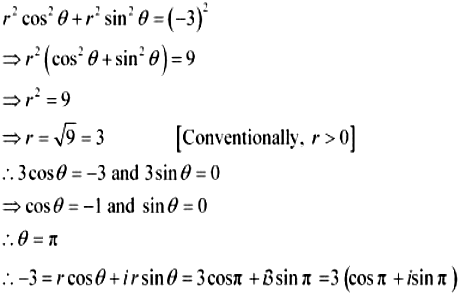18. Convert the given complex number in polar form: – 1 + i
Answer:
– 1 + i
Let r cos θ = –1 and r sin θ = 1
On squaring and adding, we obtain

It can be written,

This is the required polar form.
19. Convert the given complex number in polar form: – 1 – i
Answer:
– 1 – i
Let r cos θ = –1 and r sin θ = –1
On squaring and adding, we obtain


This is the required polar form.
20. Convert the given complex number in polar form: –3
Answer:
–3
Let r cos θ = –3 and r sin θ = 0
On squaring and adding, we obtain

This is the required polar form.
21. Convert the given complex number in polar form:
√3 + i
Answer:
√3 + i
Let r cos θ = √3 and r sin θ = 1
On squaring and adding, we obtain


This is the required polar form.
22. Convert the given complex number in polar form: i
Answer:
i
Let r cosθ = 0 and r sin θ = 1
On squaring and adding, we obtain

This is the required polar form.
23. Solve the equation x2 + 3 = 0
Answer:
The given quadratic equation is x2 + 3 = 0
On comparing the given equation with ax2 + bx + c = 0,
we obtain a = 1, b = 0, and c = 3
Therefore, the discriminant of the given equation is
D = b2 – 4ac = 02 – 4 × 1 × 3 = –12
Therefore, the required solutions are

24. Solve the equation 2x2 + x + 1 = 0
Answer:
The given quadratic equation is 2x2 + x + 1 = 0
On comparing the given equation with ax2 + bx + c = 0,
we obtain a = 2, b = 1, and c = 1
Therefore, the discriminant of the given equation is
D = b2 – 4ac = 12 – 4 × 2 × 1 = 1 – 8 = –7
Therefore, the required solutions are

25. Solve the equation x2 + 3x + 9 = 0
Answer:
The given quadratic equation is x2 + 3x + 9 = 0
On comparing the given equation with ax2 + bx + c = 0,
we obtain a = 1, b = 3, and c = 9
Therefore, the discriminant of the given equation is
D = b2 – 4ac = 32 – 4 × 1 × 9 = 9 – 36 = –27
Therefore, the required solutions are

26. Solve the equation –x2 + x – 2 = 0
Answer:
The given quadratic equation is –x2 + x – 2 = 0
On comparing the given equation with ax2 + bx + c = 0,
we obtain a = –1, b = 1, and c = –2
Therefore, the discriminant of the given equation is
D = b2 – 4ac = 12 – 4 × (–1) × (–2) = 1 – 8 = –7
Therefore, the required solutions are

27. Solve the equation x2 + 3x + 5 = 0
Answer:
The given quadratic equation is x2 + 3x + 5 = 0
On comparing the given equation with ax2 + bx + c = 0,
we obtain a = 1, b = 3, and c = 5
Therefore, the discriminant of the given equation is
D = b2 – 4ac = 32 – 4 × 1 × 5 =9 – 20 = –11
Therefore, the required solutions are

28. Solve the equation x2 – x + 2 = 0
Answer:
The given quadratic equation is x2 – x + 2 = 0
On comparing the given equation with ax2 + bx + c = 0,
we obtain a = 1, b = –1, and c = 2
Therefore, the discriminant of the given equation is
D = b2 – 4ac = (–1)2 – 4 × 1 × 2 = 1 – 8 = –7
Therefore, the required solutions are

29. Solve the equation √2x2 + x + √2 = 0
Answer:
The given quadratic equation is √2x2 + x + √2 = 0
On comparing the given equation with ax2 + bx + c = 0, we obtain
a = √2, b = 1, and c = √2
Therefore, the discriminant of the given equation is
D = b2 – 4ac = 12 – 4 x √2 x √2 = 1 – 8 = –7
Therefore, the required solutions are
